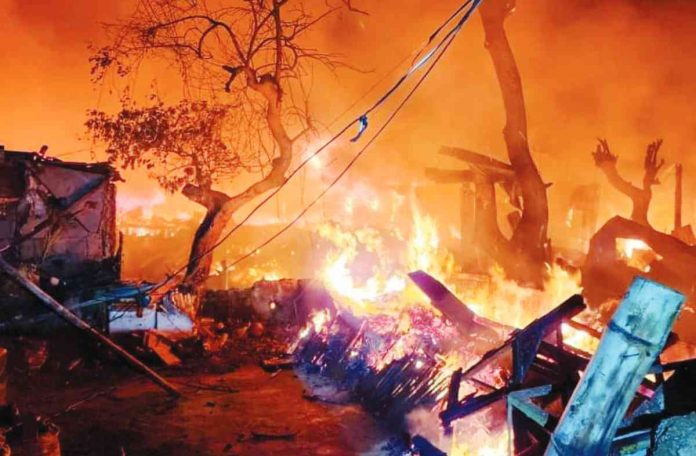
ILOILO City – Over 1,000 residents in the adjacent barangays of West Habog-Habog and San Juan in Molo district woke up to a huge conflagration around 4:37 a.m. on Saturday. The fast-spreading fire drove them out of their houses with nothing but clothes on their backs.
“Wala kami kabalo kon paano kami ma-umpisa,” said Donna Arenaza, a mother of three and a daycare center teacher.
Saturday’s blaze was one of the biggest in the city in years. According to the Iloilo City Social Welfare and Development Office (CSWDO), 195 houses in Barangay West Habog-Habog were totally damaged while three were partially damaged. In Barangay San Juan, 72 houses were totally gutted and 14 were partially damaged.
“Back to zero gid kami,” said Arenaza who family sought temporary shelter at Baluarte Elementary School also in Molo together with other displaced barangay residents.
CSWDO data showed that 201 families composed of 806 individuals from Barangay West Habog-Habog and 94 families including eight “sharers” (lumon) or a total of 324 individuals in Barangay San Juan were affected.
Most of those living in the fire-gutted area were informal settlers.
While Arenaza was thankful that she and her three children managed to flee unscathed from the early morning inferno, how to start over would be a challenge, she said.
CSWDO said no one died in the widespread fire.
Aside from Baluarte Elementary School (35 classrooms), San Juan Elementary School (3 classrooms) was also designated as a temporary evacuation center.
“We have sufficient fund for the financial aid. Importante subong ma-atindir ta sila anay,” said Mayor Jerry Treñas.
The City Heath Office sent doctors and nurses to the evacuation centers for those who need medical care.
Treñas also ordered that the two schools have sufficient clean and potable water supply to avoid another disaster – a possible outbreak of acute gastroenteritis.
Aside from the distribution of food packs, Treñas also mobilized the city government’s mobile kitchens to cook meals for the fire victims.
Private groups and individuals as well as the Department of Health (DOH) Region 6 have also started providing food and non-food items to the displaced.
DOH-6’s logistics augmentation included 100 to 150 hygiene kits, 250 treated mosquito nets, 100 collapsible water containers, 3,000 aquatabs, and medicines (lagundi, ascorbic acid, salbutamol, and multivitamins).
Treñas said the city government also coordinated with the Department of Social Welfare and Development (DSWD) for more non-food items such as blankets, sleeping mats and kitchen utensils, among others.
As of this writing, the city’s Bureau of Fire Protection is yet to issue an official report on the fire, particularly its origin and the estimate of damage.
There were initial reports that the blaze was electrical in nature.
Based on the initial report of the BFP, the fire broke out around 4:37 a.m. in Barangay West Habog-Habog. Because most of the houses were made of light materials, it speedily crept through Barangay San Juan.
The biggest fire in Iloilo City’s history erupted on Feb. 7, 1966. It broke out from a lumberyard along Iznart and quickly spread to Quezon and Valeria streets, fanned by strong winds. It gutted homes and business establishments.
The fire lasted 12 hours, as the local government’s fire trucks struggled to put out the flames – needing to travel at least three kilometers to Jaro district to refill their water tanks. When the fire was finally extinguished, it had already left nearly three quarters of what is now Iloilo City Proper a husk of its former bustling self – even then already the center of commerce in the region./PN




